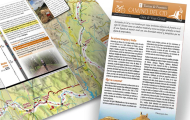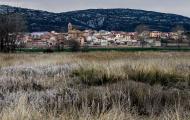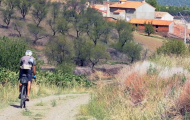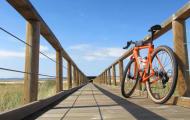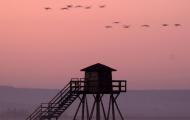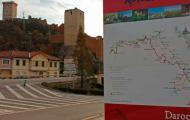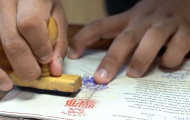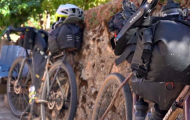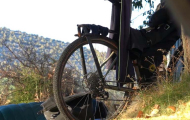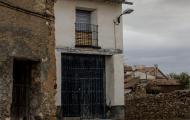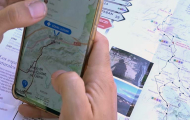Gallocanta Circular Route by Gravel Bike
ZARAGOZA - TERUEL
Gallocanta Circular Route by Gravel Bike: discover the Gallocanta lagoon by secondary roads and country lanes
- Defendant: circular, Daroca - Daroca.
- Provinces: Zaragoza and Teruel.
- Kilometres: 54 km approx.
- Recommended days: 1 day .
- Difficulty: Low - medium.

Information you can download on this page
- The gravel guide to the Gallocanta Ring.
- The list of accommodation.
- The list of tourist offices.
- The tourist brochure ( which you can request at any of the tourist offices along the route).
- The tracks of the route in gpx, kmz and trkformat .
Remember that in the Tourist Offices of the Camino del Cid you can get more information about each route free of charge: including brochures and the safe-conduct.
Download our travel app free of charge
We recommend you download our mobile travel app, available on iOS and Android. The app contains all our routes, you'll never get lost and you'll find information on 4,500 geo-referenced points (Cidian enclaves, places to see, accommodation, pass stamping points, etc.).
The app is free, updated daily and does not require registration. It also works in environments without coverage, so during installation and when you first turn it on, depending on your connection, it may take a few minutes to get it up and running, so be patient, it's worth it!

The Plot
This small but intense ring begins in Daroca. We know that the historical Cid camped for several days in this city in 1090, and that there he signed an agreement with the Catalan count Berenguer Ramón II, whom he had defeated shortly before in Maestrazgo.
The Cantar de mío Cid, in turn, also refers to Daroca and states, with little historical foundation, that the city paid tribute to the Campeador, who had subjugated the whole area with his men.
In order to impose his law, the Cid, according to the Cantar, established several camps from which he launched his raids. One of them, the best known, was located in Poyo del Cid (Teruel). The other, in Allucant.
It is not known exactly where this place is located, although some scholars believe that it is Gallocanta, a village that was known as Allucant in the 13th century. This possibility opens the doors to a very attractive circular route of great historical and ecological value, ideal for a weekend.
The journey: what you will find
This is a very quiet and fun ring for the cyclist, always on roads with little traffic, although there are some sections with bad road surfaces. The aim of the trip is to get to know the Gallocanta lagoon and its surroundings, for which an elongated ring is proposed (the only difficulty being the first few kilometres of steep ascent on leaving Daroca via the Balconchán pass).
The itinerary ends in Daroca, but not before enjoying a fun descent following forest tracks and rural roads with a good surface.
The Gallocanta Lagoon is an impressive lagoon system dotted with small villages. It is one of the largest salt lakes in Western Europe and is rich in biological diversity. Every winter, this ecosystem welcomes thousands of cranes and other migratory birds that stop here on their journeys between northern Europe and Africa.
This is a natural spectacle of the first order which, together with the large number of waterfowl, steppe birds and birds of prey it is home to (more than two hundred species), make Gallocanta one of Europe's ornithological paradises.
The history of this area is very interesting: documented human settlements date back some 4,000 years. The land is fertile, the waters of the lagoon have saline concentrations higher than those of the sea, so there have been salt and iron mining operations since ancient times, which required a large amount of firewood, leading to the deforestation of the territory and the irruption of crops and grazing areas.
It is a rich land protected by mountain ranges with two important natural passes towards the Jiloca valley and Molina de Aragón. The towns, since ancient times, were strongly defended; this explains the density of existing castles: Santed, Gallocanta (hardly any remains), Berrueco, Tornos.... Most of them are of medieval origin but are built on older remains. There are also interesting Celtiberian sites, such as El Castellar, which is located 1 km past Berrueco in the direction of Tornos.
The return journey takes us back to Daroca. This monumental city was founded by Yemeni Arabs in the 8th century, and after crossing its imposing walls, the traveller feels as if he has been transported to another era.
Daroca has a rich and varied artistic heritage as extensive as its history. The best way to discover its secrets is to wander the streets and lose yourself in its passageways, courtyards and nooks and crannies. The Islamic past is also evident in its gastronomy, and especially in its confectionery, where Mudejar plaits and almojábanas are outstanding.
Signposting
We have designed a route that is 100% adapted for gravel bikes, following rural roads with a good surface, comfortable tracks, asphalted roads and solitary roads. There is no signposting of the gravel route as such, but as it largely coincides with the MTB and hiking routes, you should pay attention to the signposting on these sections.
We recommend that you download the track or the App, and before starting your journey, checkthe Route Alerts box in our map viewer, which shows you the most important incidents you may encounter on the route: high vegetation, interrupted crossings, road works, fallen or missing signs and any other obstacle you need to be warned of.
Roads
Part of the route is on secondary roads with little or no traffic. The ascent to the Balconchán pass is on an old, disused road with some sections of uneven road surface, but the solitary scenery is worth the effort. In any case, do not forget to drive with caution and make yourself visible to vehicles.
Climatology
Winter is the harshest time of the year, with low temperatures, frequent frosts when the sun disappears and the possibility of snowfall. However, it is the time when the most spectacular migratory birds make their most spectacular stops, so the hiking challenge offers an attractive reward, despite the climatic difficulties. In any case, the environmental richness of this ring makes it advisable to walk it at any other time of the year.
Consejos y recomendaciones
- Travel safely and unhurriedly: take the tracks and route guide with you. The route is signposted and we do maintenance on the signs every year; however, signs can also disappear (by accident, the weather, vandalism) and, in that case, especially when you are in the mountains, the track and route guide become very important. The route guide also indicates the levels of difficulty of each section and it is a good idea to check it out before starting each stage. The main problem as far as getting lost is concerned comes in the villages: although we have placed signposts in many of them, we have not covered all of them and, even in those with signposts, you might not see the marks and not find the exit easily. It is best to take the tracks and route guide with you, since they contain the indications you need to follow the route.
- Food and spares. Remember to take water with you. In most of the villages, there are drinking fountains: remember to refill your water bottles before setting off again. The same applies for spare parts: remember to take a repair kit with you and the more complete it is, the greater your peace of mind will be.
- Book your accommodation in advance, especially in winter, during the high season for cranes.
- Check our cartographic viewer: the Alerts on Route shows you the most important incidents you can find on the way: tall vegetation, interrupted steps, road works, fallen or missing signs and any other obstacle from which you need to be warned about.
- Don't forget your helmet: it is compulsory for adults to wear helmets on roads outside cities and for under 16s it is compulsory at all times.
- Get your Letter of safe conduct. The Letter of Safe Conduct is a personalised 'passport' you can have stamped at many towns and villages on the Way of El Cid.
- Your literary guide. You might think it's unnecessary weight, but for many it is essential: don't forget to take with you a copy of the Song of El Cid; you will be able to recreate some of its passages on site.
REV ALC: 21.05.2025


